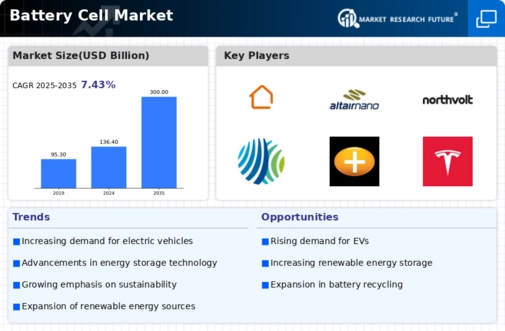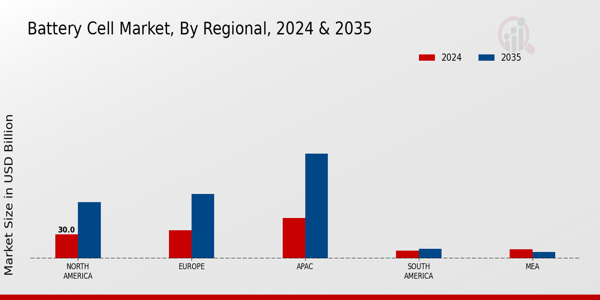Market Growth Projections
The Global Battery Cell Market Industry is poised for substantial growth, with projections indicating a market size of 136.4 USD Billion in 2024 and an anticipated increase to 300 USD Billion by 2035. This growth trajectory, characterized by a compound annual growth rate of 7.43% from 2025 to 2035, reflects the increasing demand for advanced battery technologies across various applications. The market dynamics suggest a robust competitive landscape, with numerous players vying for innovation and market share. As the industry evolves, it is likely to witness significant advancements in battery efficiency and sustainability.
Growing Renewable Energy Sector
The expansion of the renewable energy sector is a crucial factor driving the Global Battery Cell Market Industry. As countries strive to meet their renewable energy targets, the need for efficient energy storage solutions becomes increasingly apparent. Battery cells play a vital role in storing energy generated from solar and wind sources, ensuring a stable supply during peak demand. The market is expected to grow substantially, reaching 300 USD Billion by 2035, as investments in renewable infrastructure increase. This synergy between renewable energy and battery technology suggests a promising future for energy storage solutions.
Advancements in Battery Technology
Technological advancements in battery chemistry and manufacturing processes are pivotal for the Global Battery Cell Market Industry. Innovations such as solid-state batteries and lithium-sulfur technologies promise to enhance energy density and safety while reducing charging times. These developments could potentially lead to a more efficient energy storage solution, appealing to both consumers and industries. As the market evolves, the integration of artificial intelligence in battery management systems may optimize performance and lifespan. The ongoing research and development efforts indicate a dynamic landscape, where improved battery technologies could significantly influence market growth.
Government Initiatives and Policies
Government initiatives and policies aimed at promoting clean energy and reducing carbon emissions are instrumental in shaping the Global Battery Cell Market Industry. Various countries are implementing regulations and incentives to encourage the adoption of battery technologies across multiple sectors, including transportation and energy storage. These policies are likely to stimulate market growth, as they create a favorable environment for investment and innovation. The commitment to sustainability and energy efficiency suggests that the industry will continue to thrive, driven by supportive governmental frameworks and funding opportunities.
Rising Demand for Electric Vehicles
The increasing adoption of electric vehicles (EVs) is a primary driver of the Global Battery Cell Market Industry. As governments worldwide implement stringent emissions regulations and provide incentives for EV purchases, the demand for high-capacity battery cells is expected to surge. In 2024, the market is projected to reach 136.4 USD Billion, with EVs accounting for a significant portion of this growth. The transition to sustainable transportation solutions is likely to propel the industry further, as manufacturers seek to enhance battery performance and reduce costs. This trend suggests a robust trajectory for battery cell production and innovation.
Increased Investment in Energy Storage Systems
Investment in energy storage systems is a significant driver for the Global Battery Cell Market Industry. As energy consumption patterns shift and the demand for grid stability rises, utilities and businesses are increasingly turning to battery storage solutions. These systems not only enhance grid reliability but also facilitate the integration of renewable energy sources. The projected compound annual growth rate of 7.43% from 2025 to 2035 underscores the growing recognition of battery storage's importance in energy management. This trend indicates a robust market potential as stakeholders seek to optimize energy use and reduce operational costs.















